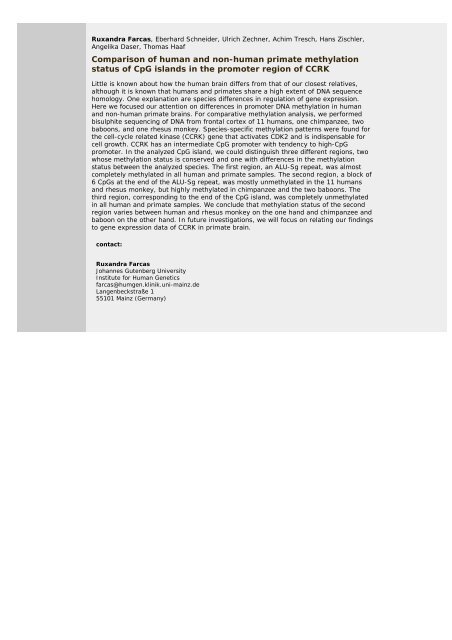Abstracts (poster) - Wissenschaft Online
Abstracts (poster) - Wissenschaft Online
Abstracts (poster) - Wissenschaft Online
Create successful ePaper yourself
Turn your PDF publications into a flip-book with our unique Google optimized e-Paper software.
Ruxandra Farcas, Eberhard Schneider, Ulrich Zechner, Achim Tresch, Hans Zischler,<br />
Angelika Daser, Thomas Haaf<br />
Comparison of human and non-human primate methylation<br />
status of CpG islands in the promoter region of CCRK<br />
Little is known about how the human brain differs from that of our closest relatives,<br />
although it is known that humans and primates share a high extent of DNA sequence<br />
homology. One explanation are species differences in regulation of gene expression.<br />
Here we focused our attention on differences in promoter DNA methylation in human<br />
and non-human primate brains. For comparative methylation analysis, we performed<br />
bisulphite sequencing of DNA from frontal cortex of 11 humans, one chimpanzee, two<br />
baboons, and one rhesus monkey. Species-specific methylation patterns were found for<br />
the cell-cycle related kinase (CCRK) gene that activates CDK2 and is indispensable for<br />
cell growth. CCRK has an intermediate CpG promoter with tendency to high-CpG<br />
promoter. In the analyzed CpG island, we could distinguish three different regions, two<br />
whose methylation status is conserved and one with differences in the methylation<br />
status between the analyzed species. The first region, an ALU-Sg repeat, was almost<br />
completely methylated in all human and primate samples. The second region, a block of<br />
6 CpGs at the end of the ALU-Sg repeat, was mostly unmethylated in the 11 humans<br />
and rhesus monkey, but highly methylated in chimpanzee and the two baboons. The<br />
third region, corresponding to the end of the CpG island, was completely unmethylated<br />
in all human and primate samples. We conclude that methylation status of the second<br />
region varies between human and rhesus monkey on the one hand and chimpanzee and<br />
baboon on the other hand. In future investigations, we will focus on relating our findings<br />
to gene expression data of CCRK in primate brain.<br />
contact:<br />
Ruxandra Farcas<br />
Johannes Gutenberg University<br />
Institute for Human Genetics<br />
farcas@humgen.klinik.uni-mainz.de<br />
Langenbeckstraße 1<br />
55101 Mainz (Germany)

















